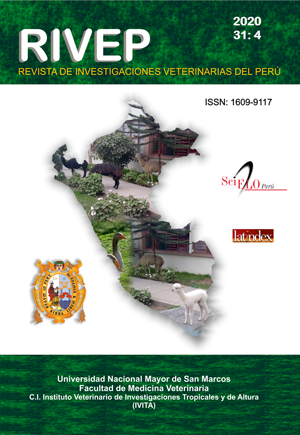Comparison of single-trait and multi-trait animal models to estimate components of (Co) variance and genetic growth parameters in the bovine breed Costeño con Cuernos
DOI:
https://doi.org/10.15381/rivep.v31i4.17380Keywords:
genetic parameters, direct effect, maternal effects, variance components, creole cattleAbstract
The study aimed to estimate the components of (co) variance and genetic parameters for growth traits as birth weight (BW), weaning weight (WW) and weight at 16 months of age (W16) of calves of the creole breed Costeño con Cuernos, born between 1989 and 2011 in a herd located in the northeast of Colombia. For this, 3060, 2594 and 1990 BW, WW and W16 records were analyzed, respectively. Single-trait (UNI) and multi-trait (MT) models were used. Six variants were evaluated with the UNI model, in all cases the random effect of the animal was included and the rest of the models alternated the maternal effect, the effect of the permanent environment and the relationship between the direct and maternal effect. Goodness of fit was determined using the information criteria of Akaike (AIC), Bayesiana (BIC) and LogL. For BW and WW models involving direct, maternal, and permanent maternal environment effects showed the best fit, and for W16 the best fit model was the one that only considered the direct effect. The heritability values of the UNI and MT models were similar for BW (0.14 and 0.16, respectively). For WW and W16, the MT model, in relation to the UNI, increased h2a by 42% (0.27 vs. 0.19; 0.31 vs. 0.21, respectively), as well as h2T for WW by 34% (0.31 vs. 0.23). The genetic variability found allows the application of a selection process and it is recommended to use the multi-trait models for the genetic evaluation of the herd.
Downloads
Downloads
Published
Issue
Section
License
Copyright (c) 2020 Juan Pérez G., Juan Fernández N., Alina Mitat, Matiluz Doria Ramos, Juan Rocha M., Alberto Menendez-Buxadera

This work is licensed under a Creative Commons Attribution-NonCommercial-ShareAlike 4.0 International License.
AUTHORS RETAIN THEIR RIGHTS:
a. Authors retain their trade mark rights and patent, and also on any process or procedure described in the article.
b. Authors retain their right to share, copy, distribute, perform and publicly communicate their article (eg, to place their article in an institutional repository or publish it in a book), with an acknowledgment of its initial publication in the Revista de Investigaciones Veterinarias del Perú (RIVEP).
c. Authors retain theirs right to make a subsequent publication of their work, to use the article or any part thereof (eg a compilation of his papers, lecture notes, thesis, or a book), always indicating the source of publication (the originator of the work, journal, volume, number and date).



